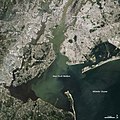ملف:Irene's Sediment in New York Harbor (6105706375).jpg

الملف الأصلي (720 × 720 بكسل حجم الملف: 231 كيلوبايت، نوع MIME: image/jpeg)
| هذا ملف من ويكيميديا كومنز. معلومات من صفحة وصفه مبينة في الأسفل. كومنز مستودع ملفات ميديا ذو رخصة حرة. |
ملخص
| الوصفIrene's Sediment in New York Harbor (6105706375).jpg |
In the wake of heavy rains from Hurricane Irene, sediment filled many rivers and bays along the U.S. East Coast. New York’s Hudson River and estuary was no exception. (To download the full high res go to: earthobservatory.nasa.gov/IOTD/view.php?id=51975 ) In this true-color satellite image, pale green and tan water flows past Manhattan and mixes with the darker waters of New York Harbor and the Atlantic Ocean. This image was acquired on August 31, 2011, when Landsat 5 acquired multiple views of the coast from the Carolinas to New York. Be sure to click on the full mosaic. Sediment plumes are prominent in Delaware Bay and along the Maryland, Virginia, and North Carolina coasts. Also, the Delaware, Hudson, and other rivers stand out as tan and brown tracings far into the interior landscape. “The sediment flux from Irene is really massive...unusual, but not unheard of,” said coastal oceanographer David Ralston of the Woods Hole Oceanographic Institution. “One big event like this can move and deposit as much sediment as you might get in several years of regular flow on the Hudson.” In the scene above, fresh water of the upper Hudson has likely pushed all the way down near Manhattan, Ralston notes, in a river that is usually a saltwater mix well into upstate New York. Tides and currents in the harbor send pulses of sediment-laden water into Raritan Bay (lower left), the Atlantic, and even up the East River into Long Island Sound. The color of the water generally depends on the amount and type of sediment, as the green, tan, and deep brown areas have varying degrees of suspended silt, sand, mud, leaf tannins, and other organic matter. Note, for instance, the darker brown tinting near the Passaic River in New Jersey (image left). The brightness, or reflectance, of the water is also an indication of how close to the top of the water column those sediments are moving. It is also possible that phytoplankton are blooming in the wake of the storm. Waterborne sediment can block some of the sunlight for aquatic plants, but the stirring of the river bottom and the runoff from land brings massive amounts of nutrients to the water's surface. The fresh water can stratify, or layer, the water column so that plankton can flourish at the surface without mixing downward. In addition to soil and sand, flooding rivers can carry sewage, pesticides, and excess fertilizer. Researchers from the U.S. Geological Survey and other institutions are collecting samples to determine the amount of pesticides, fertilizer, E. coli and other bacteria, and sediment in the water. All can contribute to poor water quality and promote algae blooms that increase costs of treating drinking water. The movement of sediment also can affect coastal shipping channels. USGS/NASA Earth Observatory image by Robert Simmon, using Landsat data from Earth Explorer. Caption by Mike Carlowicz and Rob Simmon, with image interpretation from Michael Ondrusek (NOAA), Sharyn Hedrick (Smithsonian Institution), and David Ralston (Woods Hole Oceanographic Institution). Instrument: Landsat 5 - TM NASA Goddard Space Flight Center enables NASA’s mission through four scientific endeavors: Earth Science, Heliophysics, Solar System Exploration, and Astrophysics. Goddard plays a leading role in NASA’s accomplishments by contributing compelling scientific knowledge to advance the Agency’s mission. Follow us on Twitter Like us on Facebook Find us on Instagram |
| التاريخ | |
| المصدر | Irene's Sediment in New York Harbor |
| المؤلف | NASA Goddard Space Flight Center from Greenbelt, MD, USA |
ترخيص
- يحقُّ لك:
- مشاركة العمل – نسخ العمل وتوزيعه وبثُّه
- إعادة إنتاج العمل – تعديل العمل
- حسب الشروط التالية:
- نسب العمل إلى مُؤَلِّفه – يلزم نسب العمل إلى مُؤَلِّفه بشكل مناسب وتوفير رابط للرخصة وتحديد ما إذا أجريت تغييرات. بالإمكان القيام بذلك بأية طريقة معقولة، ولكن ليس بأية طريقة تشير إلى أن المرخِّص يوافقك على الاستعمال.
| نَشَر NASA Goddard Photo and Video هذه الصُّورة على موقع فلِيكر بتاريخ https://flickr.com/photos/24662369@N07/6105706375. ورَاجَعها FlickreviewR في ٢١ أكتوبر ٢٠١٧، وتأكَّدَ أَنَّها مُرخَّصة برخصة cc-by-2.0. |
٢١ أكتوبر ٢٠١٧
الشروحات
العناصر المصورة في هذا الملف
يُصوِّر
قيمة ما بدون عنصر ويكي بيانات
٢ سبتمبر 2011
تاريخ الملف
اضغط على زمن/تاريخ لرؤية الملف كما بدا في هذا الزمن.
| زمن/تاريخ | صورة مصغرة | الأبعاد | مستخدم | تعليق | |
|---|---|---|---|---|---|
| حالي | 09:08، 21 أكتوبر 2017 |  | 720 × 720 (231 كيلوبايت) | A1Cafel | Transferred from Flickr via Flickr2Commons |
استخدام الملف
الصفحة التالية تستخدم هذا الملف:
الاستخدام العالمي للملف
الويكيات الأخرى التالية تستخدم هذا الملف:
- الاستخدام في en.wikipedia.org
- الاستخدام في es.wikipedia.org
- الاستخدام في it.wikipedia.org
- الاستخدام في pt.wikipedia.org
